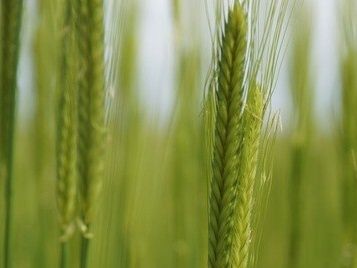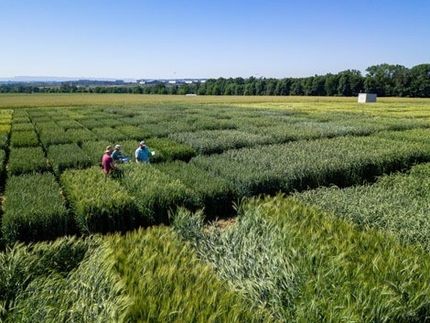Wheat, einkorn, emmer, spelt:
Large differences in protein composition
The five types of wheat - einkorn, emmer, spelt, durum and common wheat - and their varieties differ significantly in the composition of their proteins. This is the result of a large-scale study conducted by the University of Hohenheim in Stuttgart and the University Medical Center Mainz. The researchers identified a total of 2,896 different proteins in 150 flour samples. In addition to the place of cultivation, the respective variety plays a role. This could be exploited: Proteins whose occurrence depends primarily on the variety could be influenced by targeted breeding - for better baking quality, for better yields, but also for better tolerance.
Wheat is an important and generally healthy staple food for human and animal nutrition. Together with dietary fiber, minerals and vitamins, it provides about 20 percent of the daily required amount of protein when consumed with 100 to 150 g of wheat flour. At the same time, the proteins in wheat flour are important for its baking quality. That is why knowledge of the totality of all proteins formed in the grain, the so-called proteome, is of great importance - both for the selection of the right variety and for further targeted breeding research.
However, not all wheat is the same. Even though they are closely related botanically, the constituents of bread or common wheat(Triticum aestivum ssp. aestivum) and durum wheat(Triticum turgidum ssp. durum) as well as spelt (Triticum aestivum ssp. spelta), emmer(Triticum turgidum ssp. dicoccum) and einkorn(Triticum monococcum ssp. monococcum) differ. So far, however, there have been few meaningful data for a direct comparison.

The various types of wheat show great differences in the composition of their proteins - according to a study by the Universities of Hohenheim and Mainz
Universität Hohenheim / Dorothee Barsch
Milestone for future protein research
Against this background, researchers from the Universities of Hohenheim and Mainz analyzed all the proteins contained in whole wheat flour from these five different wheat species. They examined ten varieties of each species. In order to also record the influence of environmental factors, these were each grown at three different locations.
In total, the researchers were able to identify 2,896 different proteins in the 150 flour samples - over 2,500 in each species, with about half of all proteins differing between species. "To our knowledge, this is one of the most comprehensive proteome studies in cereals to date. It sets a milestone for much more targeted protein research in wheat in the future," Prof. Dr. Friedrich Longin of the State Seed Breeding Institute at the University of Hohenheim is convinced.
Protein composition depends on location and variety
For their analyses, the researchers compared the proteins found, or parts of them, with various databases - as far as possible. This is because a large proportion has not yet been studied in detail at all. "Many of the known proteins play a role in product quality, for example in the formation of cereal starch or in the stress regulation of plants, but also in allergic reactions in humans," the expert continues.
It is true that a significant proportion of proteins are formed as a result of environmental influences. But many proteins are more abundant in certain varieties. For example, the researchers identified a total of 2,540 proteins in einkorn, of which 1,940 are formed in at least one variety at all three locations. "Since genetic factors are primarily responsible for this, this is a good starting point for selecting and breeding better wheat varieties," explains Prof. Dr. Longin. To this end, the researchers have compiled lists of those proteins that could be influenced by the choice of variety.
Significantly fewer allergenic proteins in Einkorn
"Up to ten percent of people who eat products made with wheat flour complain of complaints afterwards. In them, the proteins contained in wheat lead to so-called non-celiac wheat sensitivity (NCWS), which was previously less well defined, in addition to celiac disease - an inflammatory disease of the small intestine caused by gluten proteins in wheat, or a classic (immediate type) wheat allergy. But there is also a much more common delayed-type wheat allergy, especially in patients diagnosed with irritable bowel syndrome," explains Prof. Dr. Dr. Detlef Schuppan of the University Medical Center of the Johannes Gutenberg University Mainz.
The wheat types examined differ significantly in the amount of their potentially allergenic proteins. Soft wheat and spelt have about the same total frequency of allergens. In comparison, these are reduced by a factor of about two in durum wheat and emmer and by a factor of 5.4 in einkorn. The researchers do not yet have an explanation for this phenomenon.
Above all, the amount of so-called ATIs (alpha-amylase/trypsin inhibitors) differs considerably. "They are suspected of being responsible for inflammatory reactions," explains Prof. Dr. Stefan Tenzer from the Institute of Immunology at the University Medical Center Mainz. "Compared to the other wheat species, einkorn has a significantly lower amount of ATIs."
Clinical studies urgently needed
However, the researchers point out that they estimated the allergenic potential exclusively by matching it against databases that also list possible allergenic proteins. Targeted studies would have to show whether these results are also clinically relevant. "Against the background of our results, a clinical study with einkorn compared to modern wheat would be particularly interesting," says Prof. Dr. Dr. Schuppan. In this context, the comprehensive mapping could help, for example, to design representative test diets.
"In order to find more compatible products, especially for people with wheat-related diseases, we also need to investigate the influence of different processes in flour and bread production, such as a long sourdough fermentation, on allergens," emphasizes Prof. Dr. Longin.
Outlook: Einkorn as a sustainable crop for marginal lands
In addition to the lower amount of potential allergens, einkorn contains more protein and significantly higher amounts of secondary plant compounds, vitamins and minerals compared to common wheat. Einkorn is also interesting from an agricultural point of view: "It has almost complete resistance to fungi. Moreover, it can be sown either before or after winter, which is not the case with other cereals," explains Prof. Dr. Longin.
However, einkorn delivers a much lower yield than common wheat under good soil conditions. "In marginal lands, however, such as sandy soils, higher elevations in mountainous regions or where the use of nitrogen fertilizer is not possible, good results are achieved with einkorn, while the productivity of common wheat drops," says the scientist, describing a possible area of application.
Note: This article has been translated using a computer system without human intervention. LUMITOS offers these automatic translations to present a wider range of current news. Since this article has been translated with automatic translation, it is possible that it contains errors in vocabulary, syntax or grammar. The original article in German can be found here.


























































